Exploring Fungicidal Soap: Benefits for Agriculture
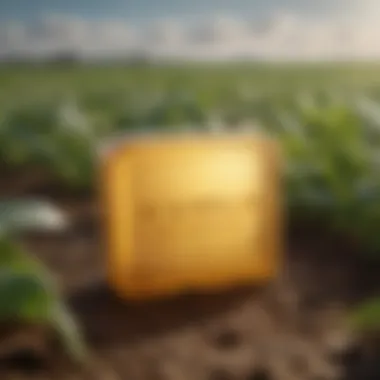

Intro
The agricultural sector faces a multitude of challenges, ranging from pests to diseases that can devastate crops and affect food security. Among the myriad of pest control options, fungicidal soap is carving out a niche as a valuable and effective alternative for farmers seeking sustainable solutions.
This article takes a look at the composition, application, and effectiveness of fungicidal soap within agricultural practices. Let’s dive into the essence of the topic, examining not only its advantages but also the nuances that make it relevant in today’s quest for eco-friendly farming strategies.
Overview of the Topic
Definition and Importance
Fungicidal soap is a plant-based pesticide, primarily composed of natural fatty acids and other organic materials. Its primary function is to control fungal infections and certain pests by disrupting their cellular functions. Unlike many synthetic pesticides, this product is biodegradable, presenting a lower risk to human health and the environment. Farmers and agricultural enthusiasts are increasingly turning to this solution, aligning their practices with modern sustainable farming principles.
The significance of fungicidal soap extends beyond mere pest management; it plays a role in enhancing plant health and yields. It helps maintain soil integrity and fosters biodiversity in agroecosystems, making it invaluable in the eyes of eco-conscious farmers.
Current Trends
In recent years, the shift towards organic farming has propelled the popularity of fungicidal soap. Notably, global consumer demand for organic products has surged, prompting farmers to adopt greener pest control methods. Fungicidal soaps are becoming staples in integrated pest management programs, as their efficacy is recognized alongside a holistic approach to farming.
Several agricultural conferences and forums are echoing the harmony between sustainable practices and economic viability, showcasing fungicidal soap as a viable contender in this narrative. Conversations around sustainable practices on platforms like Reddit and productive discussions on Facebook are emphasizing shared experiences and methods that incorporate these soaps effectively.
Key Techniques and Practices
Step-by-Step Guide
Applying fungicidal soap effectively requires a bit of know-how. Here’s a straightforward guide to get you started:
- Select the Right Product: Look for commercially available fungicidal soaps, ensuring they are labeled for agricultural use.
- Dilution is Key: Prepare the solution as directed. Generally, a dilution of 2-3 tablespoons per gallon of water is common, but always check the label.
- Timing Matters: Apply in the early morning or late evening to minimize the risk of evaporation or harm to beneficial insects.
- Target Application: Spray directly onto affected plants, covering both the upper and lower leaf surfaces.
- Follow-Up: After 7-10 days, assess the impact. Reapplication might be necessary depending on the severity of the infestation.
Tools and Equipment Needed
To implement fungicidal soap effectively, equip yourself with:
- A sprayer (manual or backpack varieties work well)
- Measuring tools for accuracy
- Personal protective equipment (gloves, mask, and goggles) to ensure safety
- Clean water source for dilution
Challenges and Solutions
Common Obstacles
Despite its advantages, there are challenges associated with fungicidal soap. The soap might not be effective against all types of fungi and pests, and overdosing can lead to leaf burn or inhibit plant growth. Furthermore, its effectiveness can vary based on environmental conditions, requiring careful monitoring.
Innovative Solutions
Farmers facing challenges can consider a few strategies to improve their experience with fungicidal soaps:
- Integrated Use: Combine with other organic pest control methods for better outcomes.
- Regular Monitoring: Conduct frequent inspections of crops to detect issues early on, allowing timely application.
- Test Small Areas First: Before widespread application, test on a few plants to assess the response.
Successful pest management is often about observation and adapting strategies to fit the specific needs of the crop and environment.
In summary, this overview sets the stage for an in-depth look at fungicidal soap's role in agriculture, offering an understanding of its composition, relevance, and practical applications. As we move forward in the article, we will further analyze its implications for crop health and sustainable farming.
Foreword to Fungicidal Soap
Fungicidal soap has emerged as an essential tool in the arsenal of modern agriculture. This section serves as a gateway into understanding why fungicidal soap is gaining traction among farmers and agricultural enthusiasts. The increasing concerns about the environmental impact of chemical fungicides coupled with the desire for sustainable practices has led to a reevaluation of pest management strategies. Fungicidal soap is not just a trend; it's a response to pressing agricultural needs.
Using a natural approach to combat fungal diseases can appeal not only to eco-conscious farmers but also supports integrated pest management (IPM) practices. Integrating fungicidal soap into farming routines aligns with current research advocating for reduced chemical usage, reinforcing its relevance in sustainable agriculture.
Definition and Overview
Fungicidal soap is fundamentally a biodegradable solution designed to manage and control fungal pathogens that can wreak havoc on crops. Typically made from plant oils and fats, it operates by disrupting the cellular membranes of targeted fungi, causing them to dehydrate and die off. This formulation makes it distinctively different from traditional synthetic fungicides, offering a gentler yet effective manner to tackle fungal problems in agriculture.
Advantages of fungicidal soap include:
- Eco-friendliness: It breaks down into non-toxic components, significantly lowering environmental risk.
- Targeted action: Its mechanism is generally selective, posing minimal risk to beneficial organisms.
- Low resistance potential: Unlike conventional fungicides, fungal resistance development is less likely with these soaps due to their varied composition.
In essence, fungicidal soap provides a modern solution rooted in historical practices, making it an attractive option for contemporary farming.
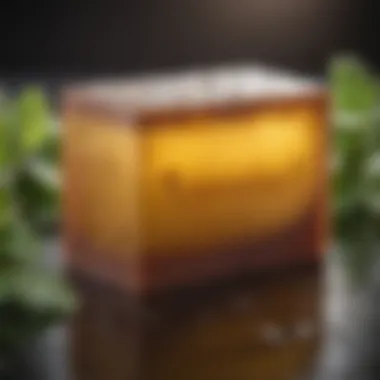
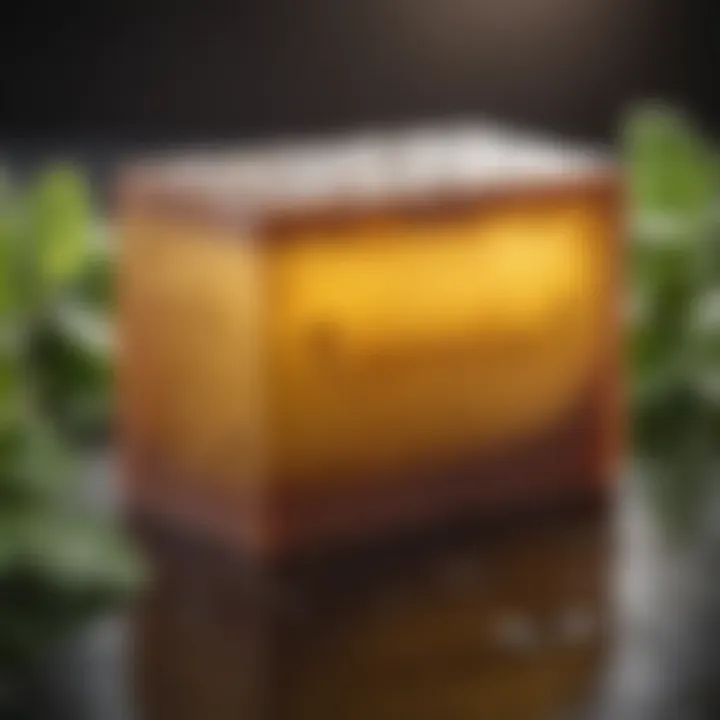
Historical Context
Looking back, the use of soap in agriculture traces its roots to ancient farming practices, where various natural substances were utilized to fend off pests and diseases. The advent of the 20th century saw a surge in synthetic pesticides and fungicides, overshadowing these traditional methods.
However, recent decades have witnessed a renaissance of interest in organic and sustainable agricultural practices. The reintroduction of natural materials, including soaps, reflects a broader shift towards methods that complement nature rather than combat it. Countries like Japan have promoted eco-farming practices which include the use of natural fungicides like fungicidal soap as a primary method of pest management.
This historical embrace of natural solutions underscores a critical relationship between agriculture and ethical stewardship of the land, advocating for practices that ensure both crop health and environmental sustainability.
Composition of Fungicidal Soap
Understanding the composition of fungicidal soap is pivotal in grasping its role in modern agriculture. Given the increasing demand for sustainable practices, it is essential to consider what goes into these soaps and how their unique properties fulfill the needs of farmers and cultivators. In this section, we will delve into the key ingredients and the chemical mechanisms through which fungicidal soap operates, equipping readers with the knowledge to make informed choices in their agricultural endeavors.
Key Ingredients
Fungicidal soaps are primarily made from the saponification of fatty acids combined with lipids. These key ingredients serve various functions:
- Fatty Acids: Usually derived from vegetable oils such as coconut or olive oil, fatty acids play a fundamental role. These compounds help dissolve the protective membranes of fungi, leading to their eventual demise. However, it is critical to note that not all fatty acids are created equal; the specific type and concentration significantly influence the soap's effectiveness.
- Potassium Hydroxide: This alkaline compound is used in the saponification process. It enables the conversion of fats into soap, ensuring that the product maintains a suitable pH level that can effectively combat fungal pathogens without causing undue harm to the crops.
- Water: The solvent in which the other ingredients are blended. The purity and quality of the water can also impact the final product's performance, making it a critical stakeholder even if seemingly trivial.
- Additional Additives: Some formulations may include botanical extracts or essential oils. These not only enhance effectiveness against certain pests but may also provide pleasant scents or additional antimicrobial properties.
All these ingredients collectively inform the product's efficacy in treating fungal diseases it encounters in agricultural settings.
Chemical Mechanisms
The way fungicidal soap works is noteworthy. Its mechanisms are not simply about direct contact; they involve a more intricate process:
- Disruption of Fungal Cell Membranes: Once the soap is applied, its fatty acids integrate into the fungal cells, disrupting their membranes. This disruption causes the contents of the cells to spill out, leading to cell lysis and fungal death. This is akin to using a Trojan horse—sneaking into enemy territory only to destabilize it from within.
- Inhibition of Spore Germination: Through disrupting the moisture retention of spores, fungicidal soap can inhibit their germination. Essentially, it creates an environment that is less favorable for fungal growth.
- Contact Activity: Unlike many synthetic fungicides that require systemic action, fungicidal soaps act primarily through contact. If a farmer can ensure thorough application, they can increase the likelihood of the soap making contact with fungal pathogens, thus boosting effectiveness.
"The integrity of the cell wall is critical for fungal survival, and fungicidal soaps take advantage of this fragile aspect."
These chemical mechanisms highlight why proper application and timing are crucial when using fungicidal soap in agricultural practices. Understanding how these soaps interact with fungal pathogens enables farmers to deploy them more effectively, leading to healthier crops and sustainable farming results.
Efficacy of Fungicidal Soap
Understanding the efficacy of fungicidal soap is crucial for anyone keen on achieving reliable pest management results. This section examines not only how effective these soaps are in combating detrimental fungi but also what benefits they bring to sustainable farming practices. By getting a grip on this topic, agriculture professionals can make more informed decisions about their pest control strategies, leading to increased crop viability and healthier ecosystems.
Case Studies
Diving into real-world applications can shed light on the tangible benefits of fungicidal soap. One notable case occurred in a small organic farm in California, where farmers faced an onslaught of powdery mildew on their zucchini crops. Traditional mildew treatments, laden with harsh chemicals, often led to yield loss and watered-down taste. After switching to a fungicidal soap, they noted a remarkable reduction in fungal presence—approximately 60% lower compared to prior seasons. This not only revived the plants but also enhanced the fruit’s taste and texture, leading to higher market demand.
Another case is found in a vinery located in Oregon. Pest management was a perennial challenge there, particularly with the infamous botrytis cinerea mold, which can devastate grape production. Research showed that implementing fungicidal soap in conjunction with agricultural practices like crop rotation led to significant reductions in disease incidence. The result? Healthier grapes and a decreased need for synthetic interventions, which in turn optimized the vineyard’s biodiversity—an unexpected yet delightful bonus.
To sum it up:
- Real-world effectiveness: Demonstrated significant reductions in fungal infections.
- Benefits: Improved taste and quality in crops.
- Biodiversity: Adoption of these soaps often leads to healthier ecosystems.
Comparative Analysis with Conventional Fungicides
When put side by side with conventional fungicides, fungicidal soaps often come out as a safer, more sustainable option. Conventional pesticides may deliver rapid results, but they rarely come without baggage—like development of resistant fungal strains and negative impacts on non-target organisms.
Research has shown that while standard fungicides reduce fungal loads quickly, they also create a risk of resistance development. For example, a university study highlighted that overuse of traditional treatments in apple orchards resulted in a 30% rise in resistant fungal strains over just five years. In contrast, the use of fungicidal soap, which works by breaking down the protective membranes of fungi, reduces reliance on chemical methods.
Here are key points from the comparison:
- Speed vs. Sustainability: Conventional methods may be faster but lack long-term ecological benefits.
- Resistance: Fungicidal soaps can mitigate issues surrounding resistance development.
- Non-target effects: Traditional fungicides can harm beneficial organisms, while soaps are generally safe for them.
"The best approach often combines knowledge of efficacy with an understanding of ecological impact."
This insight can lead agriculture professionals and enthusiasts to adopt fungicidal soaps as a staple in their pest management strategies.
Applications in Agriculture
The role of fungicidal soap in agriculture extends beyond simple pest control; it embodies a paradigm shift towards more sustainable farming practices. These products offer a unique approach to managing fungal diseases that affect crops. In this section, we will unpack the specific elements that make these soaps crucial for contemporary agricultural operations. The correct application of fungicidal soap can lead to healthier plants, reduced chemical residues, and a lowered environmental footprint.
Crop Types and Suitability
Fungicidal soaps are notably versatile. They can be effectively used across a variety of crop types, making them appealing to farmers aiming for both diversity in cultivation and disease management. Examples of crops that benefit from fungicidal soap include:
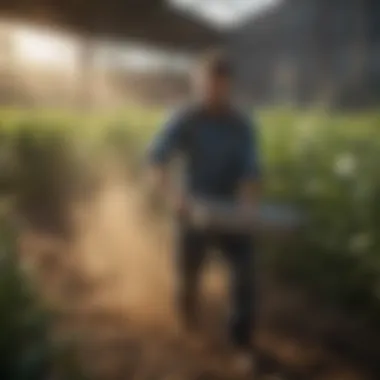

- Tomatoes: One of the most common vegetables, tomatoes are prone to diseases such as powdery mildew. Fungicidal soaps can limit the spread of these infections.
- Cucumbers: Known for their susceptibility to downy mildew, cucumbers experience significant yield losses without intervention; fungicidal soap has shown efficacy in combating this very issue.
- Ornamental Plants: Many garden enthusiasts appreciate these soaps for maintaining the health of their flower beds without resorting to harsh chemicals.
However, suitability isn’t just a matter of crop type; environmental factors come into play, too. For instance, application timing is critical. Using fungicidal soap in late evening or early morning minimizes evaporation and ensures higher efficacy against fungal spores. Understanding your local pest conditions and plant types will yield the best results when using these soaps.
Preparation Methods
Getting the preparation right is key to effective use. The concoction of fungicidal soap can vary, but typically it involves mixing the soap with water to create a solution that can penetrate plant surfaces effectively. Here are some common approaches to preparing fungicidal soap:
- Dilution Ratio: Generally, a ratio of 1-3 tablespoons of concentrated soap per gallon of water is common, but the instructions vary by product. It's vital to follow the package recommendations to avoid plant damage.
- Testing on a Small Area: Before applying it liberally, farmers should use a patch test on a small portion of the plant to check for adverse reactions.
- Stirring: A gentle stir ensures that the soap dissolves evenly in the water, creating a homogenous mixture without creating undue foam.
Ultimately, preparation is about finding what works best for the specific conditions of your farm while adhering to expected guidelines.
Application Techniques
When it comes to application, precision is paramount. The following techniques can enhance the delivery and effectiveness of fungicidal soap.
- Spraying: Using a sprayer ensures even coverage. The spray should target the upper and lower surfaces of leaves, as fungal spores can reside in neglected areas.
- Drenching: For certain types of plants, allowing the soap solution to seep into the soil can also provide some control against rootborne pathogens.
- Frequency: Regular applications are essential, particularly at the onset of disease symptoms. This approach creates a protective barrier on leaf surfaces.
It's important to remember that environmental conditions can impact the effectiveness of the application. Factors like humidity, wind, and exposure to sunlight should be considered. Following these guidelines will help maintain the integrity and performance of fungicidal soap as a primary tool in sustainable agricultural practices.
"Incorporating fungicidal soap into your agricultural routines not only protects crop health but also contribute to eco-friendly solutions in the agricultural sector."
Environmental Impact
The environmental impact of fungicidal soap is a critical consideration, especially in an era where sustainable agricultural practices are becoming increasingly vital. As farmers and enthusiasts seek safer alternatives to conventional pesticides, understanding the ecological ramifications of fungicidal soap becomes paramount. This section delves into two main facets: its biodegradability and persistence as well as its effects on non-target organisms.
Biodegradability and Persistence
One of the standout features of fungicidal soap is its biodegradability. Unlike synthetic chemicals that tend to linger in the environment, fungicidal soap breaks down into simple, non-toxic components, minimizing long-term ecological footprints. This quality is particularly essential when considering soil health and water resources, as it reduces the risk of chemical run-off contaminating local waterways.
Here’s a glimpse of what makes fungicidal soap a preferable option:
- Natural Ingredients: Generally made from plant oils and fats, these soaps contribute to a lower impact on soil microflora compared to traditional fungicides.
- Rapid Breakdown: Fungicidal soaps typically degrade within days to weeks, which means they pose less risk to plants and microbial activity in the soil.
- Environmental Regulations: More regions are adopting stricter environmental regulations, emphasizing the need for solutions that align with these guidelines.
Consequently, the use of fungicidal soap can aid in maintaining ecosystem balance while providing effective pest control.
"Biodegradable products allow farmers to cultivate sustainably, ensuring both plant health and environmental integrity".
Effects on Non-target Organisms
Another cornerstone of the environmental discussion surrounding fungicidal soap pertains to its effects on non-target organisms. Unlike broad-spectrum fungicides that often indiscriminately affect beneficial insects and other forms of wildlife, fungicidal soap is notably more selective. Here are some insights into its impact:
- Minimal Disruption: Because fungicidal soaps primarily target fungal pathogens, they typically have a much lesser impact on beneficial insects like pollinators. This makes them a strategic choice where crop health and biodiversity must coexist.
- Reduced Toxicity: The low toxicity levels of these soaps render them less harmful to non-target organisms, including earthworms and predatory insects vital to pest management.
- Integration with Biodiversity: By utilizing fungicidal soap, farmers can strengthen their crop management strategies without undermining surrounding ecosystems.
In summary, the environmental impact of fungicidal soap is evidence of its role in advancing sustainable agriculture. Its biodegradable nature and limited effects on non-target species make it a thoughtful option for modern farming practices, further solidifying its position as a key tool in eco-friendly pest management.
Safety Considerations
Safety considerations play a pivotal role when integrating fungicidal soap into agricultural practices. Understanding the implications for both human health and the environment cannot be understated. As farmers and green thumbs delve into using this product, prioritizing safety is key in maximizing its benefits while minimizing risks. By doing so, practitioners not only safeguard their health but also maintain the integrity of the ecosystem in which they operate.
Human Safety Protocols
Implementing human safety protocols is vital for anyone handling fungicidal soap. Even though this agricultural input is generally deemed less harmful than many conventional chemicals, taking precautions is still essential to avoid unintended mishaps.
- Personal Protective Equipment (PPE): Always wear gloves, goggles, and a mask when applying fungicidal soap. This simple layer of protection can prevent skin irritations and respiratory issues that might arise from accidental exposure.
- Label Instructions: Familiarize yourself with the product label before use. These labels often contain important safety information, including first-aid measures in case of accidental ingestion or contact with skin. Ignoring this can lead to regrettable consequences.
- Safe Storage Practices: Store fungicidal soap in a cool, dry place away from direct sunlight. Ensure that it is kept out of reach of children and pets. Misplacing these products can lead to unforeseen accidents.
Moreover, it is recommended to avoid applying fungicidal soap during windy days or when rain is expected shortly after application. This not only minimizes exposure to oneself but also reduces the risk of drift into unintended areas.
Best Practices for Application
Adopting best practices for the application of fungicidal soap increases its efficacy and safety. Proper technique does not just concern how the product works, but also considers the health of the applicator and surrounding beings. Here are some guidelines:
- Preparation of Mixture: When preparing fungicidal soap solutions, follow the recommended dilution ratios specified on the label. Over-concentration might damage plant tissues, while under-strength solutions may not be effective in fighting pests.
- Timing: Apply fungicidal soap during cooler parts of the day, either in the early morning or late afternoon. This reduces the risk of phytotoxicity and ensures better absorption by the plants.
- Targeted Application: Use a spray bottle or a targeted sprayer aimed directly at infected areas. Avoid broad spraying that may lead to unnecessary contact with healthy plants or beneficial insects.
Applying fungicidal soap precisely where it's needed not only enhances its effectiveness but also protects your unwanted neighbors, like bees and ladybugs, that are vital to a thriving ecosystem.
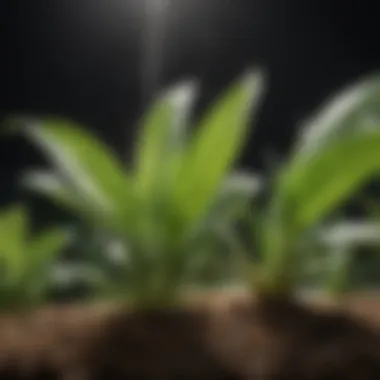
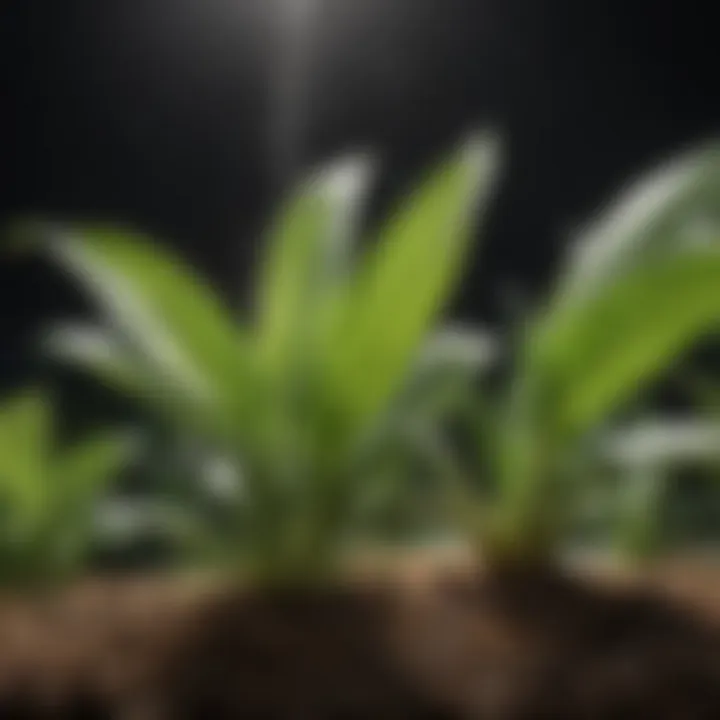
- Follow-up Monitoring: After application, monitor the crops for signs of phytotoxicity or pest resistance. This vigilance can aid in timely adjustments, ensuring that plant health is never compromised.
Challenges and Limitations
Understanding the challenges and limitations of fungicidal soap is crucial for farmers and agricultural enthusiasts. While this method of pest management offers many benefits, it isn't without its drawbacks. Navigating these hurdles can be the difference between a thriving crop and a failing one.
Resistance Development
One pressing issue with fungicidal soaps is the potential for resistant strains of fungi to develop over time. This resistance can compromise the effectiveness of the soap, making it crucial for agriculturalists to diversify their pest management strategies.
Farmers often find themselves in a tug-of-war as microorganisms adapt to repeated exposure. Think of it as a game of whack-a-mole; as soon as one pest is dealt with, another unmasked form of resistance pops up. This phenomenon is not just a theoretical potential—numerous case studies demonstrate it happening in real-world scenarios.
For example, crops frequently treated with fungicidal soap may eventually require stronger, more harmful chemicals if resistant strains take root. This reality leads many in the agricultural field to promote a rotation strategy among various pest control methods, integrating fungicidal soaps with other biological or synthetic treatments. The goal is to manage resistance effectively while maintaining eco-friendliness.
- Regularly varying active ingredients can lessen the risk of resistance.
- Interval applications, avoiding back-to-back usage of the same product, help slow down resistance development.
Regulatory Constraints
In addition to resistance issues, regulatory constraints are another significant concern for agriculturalists interested in using fungicidal soap. Various countries have differing rules and regulations governing the use of such soaps in agriculture.
Navigating these regulations can often feel like walking through a maze. In some regions, using certain types of soaps might require special permits or adherence to strict application protocols. For example, where one might assume that a product needs merely a simple label, it might in fact demand documentation of safe use, impact assessments, and potentially even environmental studies.
The regulations surrounding fungicidal soaps often aim to ensure that they do not negatively affect non-target organisms or contribute to the degradation of soil and water quality. Farmers must be diligent in staying updated on these evolving laws, which can vary not just from one country to another but sometimes even from state to state.
- Understanding local regulatory frameworks is essential for compliance.
- Staying informed through agricultural extension services or industry associations can prove beneficial.
"The best way to handle restrictions is to read them carefully and integrate them into your methods from the start. Missing a tiny detail can trip up your entire operation."
In summary, while fungicidal soap can be a game-changer in agricultural pest management, awareness of the challenges like resistance development and regulatory constraints is necessary to utilize it effectively.
Farmers committed to sustainable practices must incorporate these considerations into their comprehensive management plans to foster healthy crops and thriving ecosystems.
Emerging Trends in Fungicidal Soap Use
In recent times, the agricultural landscape has witnessed a noticeable shift towards more sustainable practices. This makes understanding the emerging trends in the use of fungicidal soap, frankly, a topic that farmers and agronomists cannot afford to ignore. Following both consumer preferences and regulatory changes, fungicidal soap has begun to carve its niche not just as another tool in the agricultural toolkit but as a linchpin in integrated pest management strategies. Key some aspects of this trend include innovations in formulations, which enhance effectiveness while reducing environmental harm, and the growing integration with other eco-friendly practices.
Innovation in Formulations
Recently, researchers and manufacturers have been hard at work refining fungicidal soap formulations. These innovations focus on increasing effectiveness while ensuring safety for crops and the environment. Newer formulations often blend various soap types, sometimes even incorporating plant extracts that have natural antifungal properties.
For example, some products might combine oleic acid with potassium salts to create a surfactant that not only targets fungal spores but also enhances the overall health of the plant. Such formulas can lead to better absorption and improved pest resistance, making them particularly appealing for organic growers.
- Benefits of Innovative Formulations
- Enhanced effectiveness against a broader spectrum of pests;
- Reduced phytotoxicity, allowing for safer use on sensitive crops;
- Improved adherence to plant surfaces, maximizing contact time with pests.
As agronomists explore amended mixes, it’s crucial for farmers to stay updated about these changes, as navigating the choices available could mean the difference between a successful season and a struggle against persistent fungal infestations.
Integration with Other Eco-friendly Practices
What’s more, the incorporation of fungicidal soap into broader eco-friendly practices is becoming more prevalent. Farmers are finding that using fungicidal soap in conjunction with other sustainable methods can amplify benefits. For instance, when paired with practices such as crop rotation or the introduction of beneficial insects, the overall pest management approach is vastly improved.
This integration brings forth several advantages:
- Holistic pest management: By combining fungicidal soap with biological pest control methods, farmers can create an ecosystem that supports beneficial organisms while effectively managing harmful pests.
- Soil health: Using these soaps can help maintain soil flora, as they are less disruptive than more aggressive fungicides. Maintaining a healthy soil biome contributes significantly to overall crop resilience and productivity.
- Cost-efficiency: Many farmers find costs decrease over the long run when integrating these practices, as they often rely on fewer inputs while achieving better results.
Finale
The conclusion serves as a critical wrapping of insights drawn from the extensive exploration of fungicidal soap in the realm of agriculture. By synthesizing the information collected throughout the article, it emphasizes the importance of understanding the nuances of fungicidal soap. The reader should walk away with a clear picture of its benefits, challenges, and future potential in sustainable farming practices.
Synthesizing Key Insights
Fungicidal soap emerges not only as a practical tool to combat fungal threats but also as a sustainable choice that aligns with the growing demand for eco-friendly agricultural practices. Here are the core insights:
- Eco-friendliness: Unlike many synthetic fungicides, fungicidal soap is derived from natural sources, making it safer for both the environment and those tending to crops.
- Ease of Use: The application of fungicidal soap is often straightforward, requiring minimal equipment and preparation. This accessibility enables more farmers, especially smaller operators, to adopt it seamlessly into their pest management strategies.
- Specialized Efficacy: While it's not a silver bullet, the soap effectively targets certain pests and pathogens, providing another layer of protection for crops.
- Integration with Other Practices: Fungicidal soap can be synergistically combined with other organic pest management practices, enhancing overall effectiveness while supporting sustainable goals.
Ultimately, these insights underline the pivotal role fungicidal soap may play in shaping a more sustainable agricultural future.
Future Outlook for Fungicidal Soap in Agriculture
Looking ahead, the future of fungicidal soap appears promising yet nuanced. Here are some elements to watch:
- Research and Development: Ongoing innovation in formulations is likely to enhance efficacy. There is potential for creating blends that target specific pathogens more effectively, or even enhancing the residence time on crops to improve effectiveness.
- Market Growth: With the rise of consumer awareness about pesticides and sustainability, demand for organic solutions like fungicidal soap will likely increase. Farmers may find themselves at the forefront of an evolving market as consumers steer away from chemically-intensive produce.
- Education and Training: Greater emphasis will be placed on educating farmers about the best practices for using fungicidal soap, which ties directly into its successful implementation in various agricultural settings.
- Regulations: As regulations surrounding agricultural chemicals evolve, fungicidal soap may face fewer restrictions compared to conventional fungicides. This could open doors for broader adoption.



